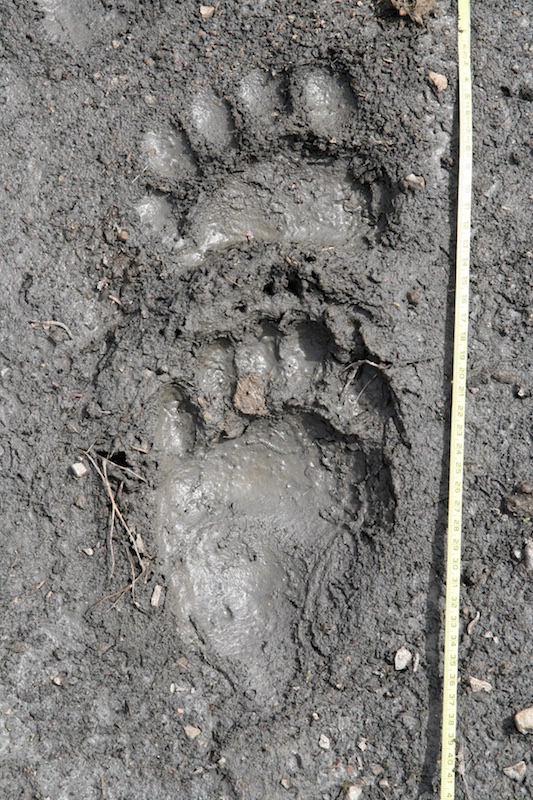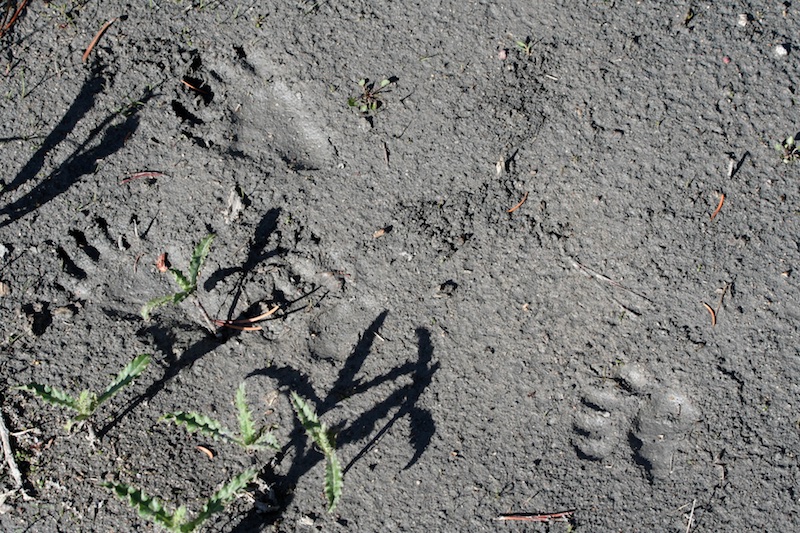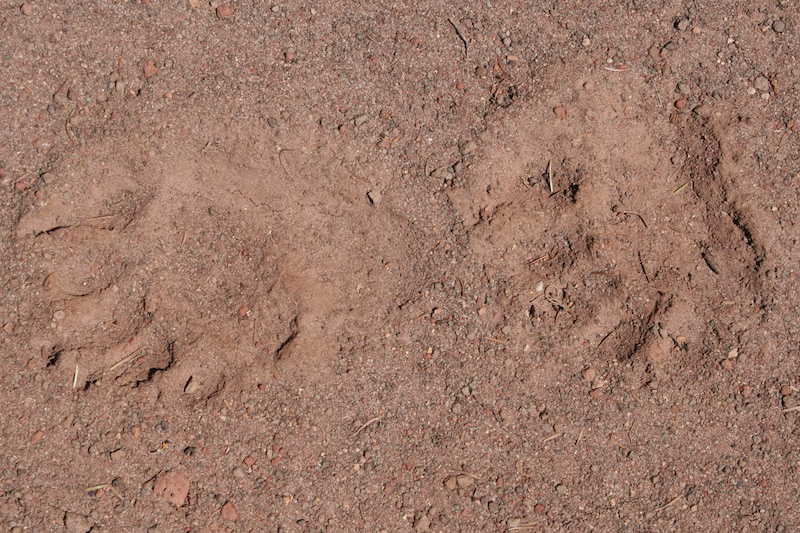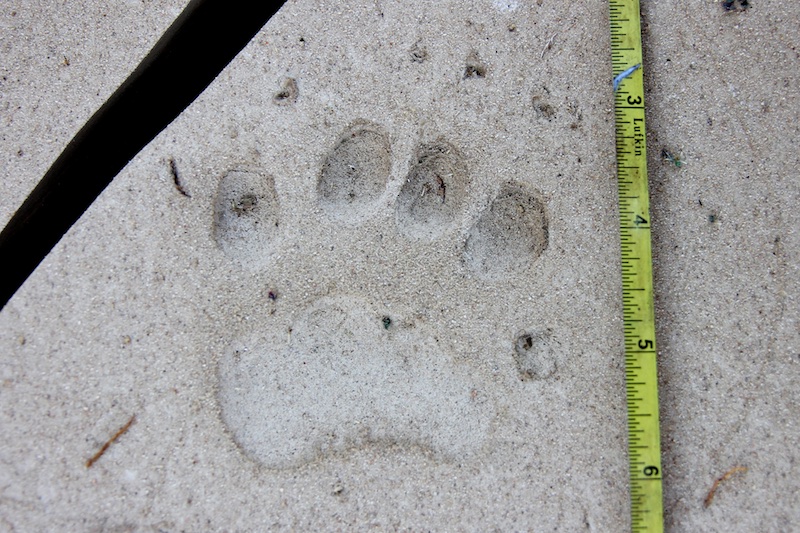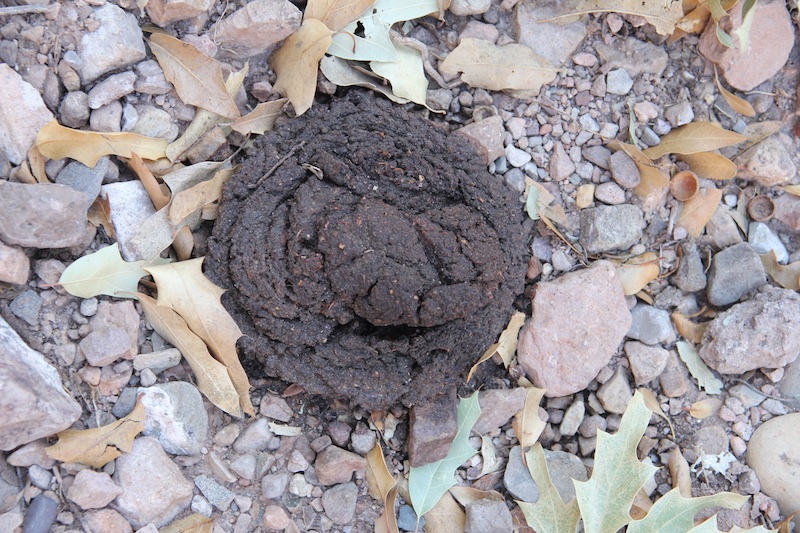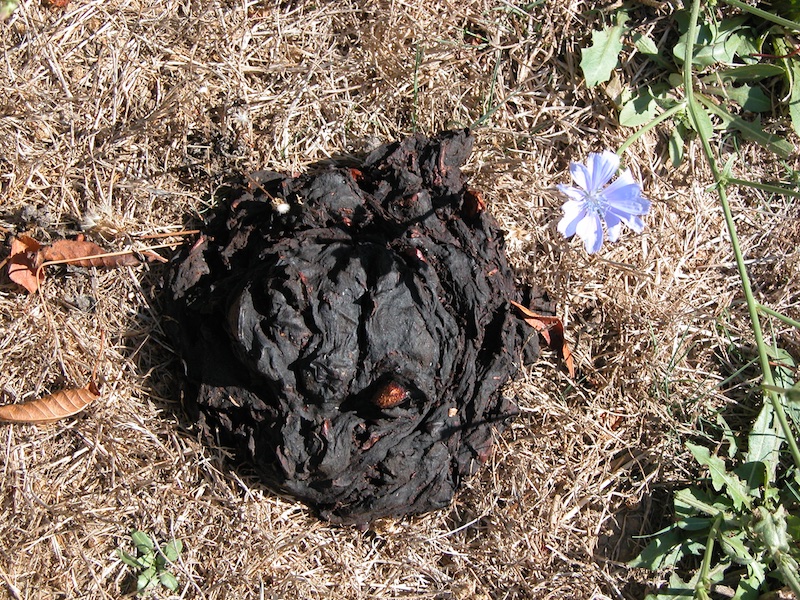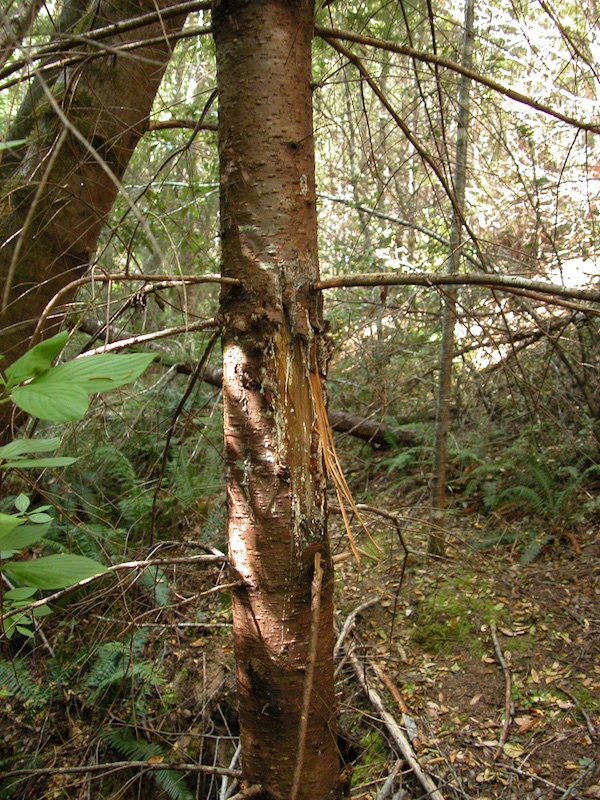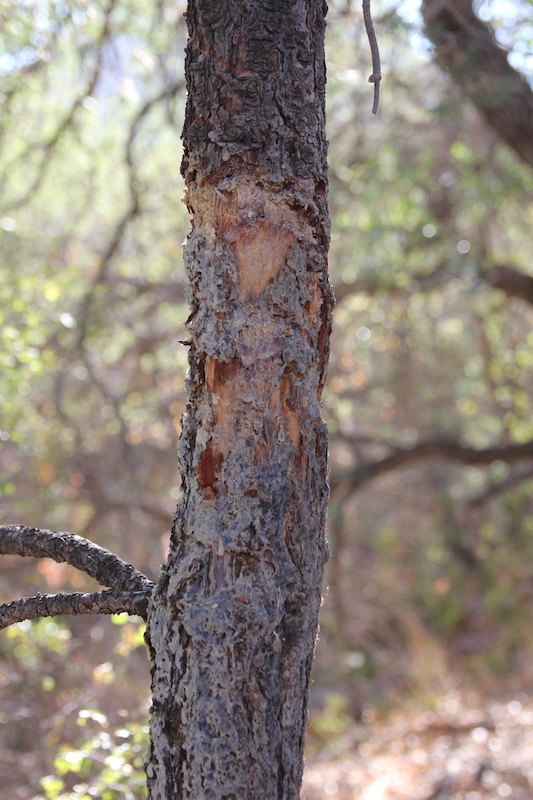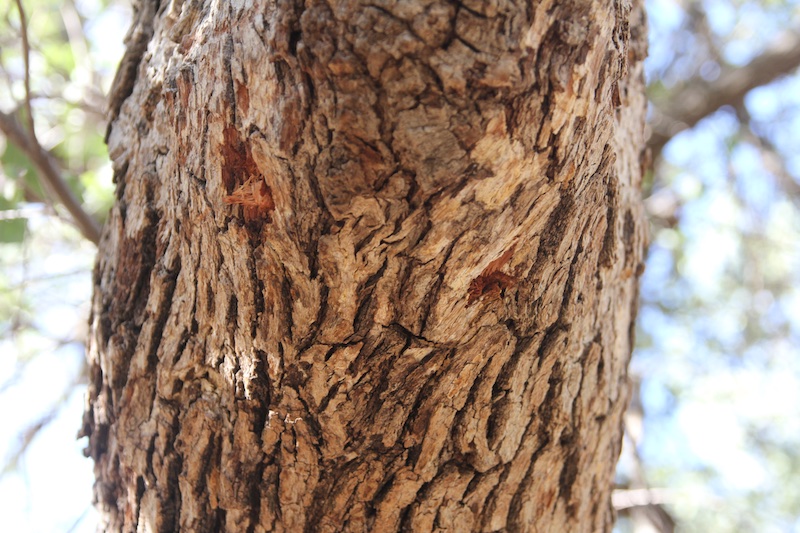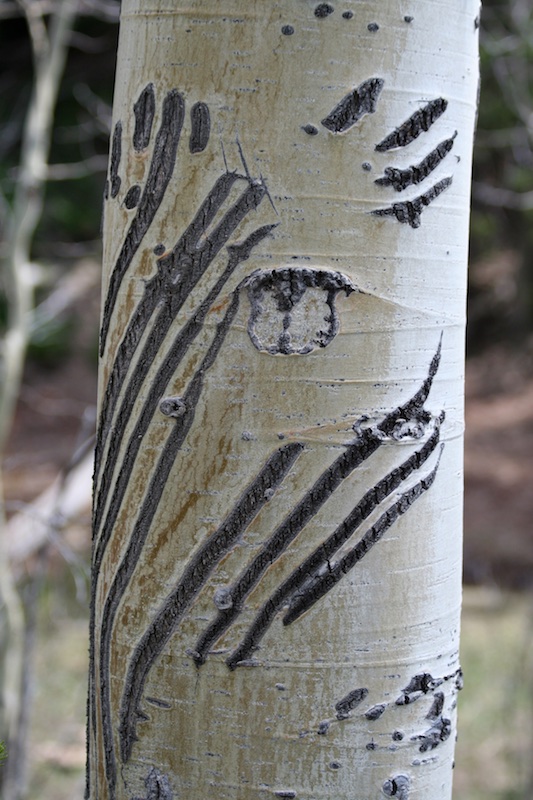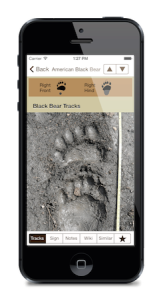Black Bear Right Front Track
- 2.1 – 5.3 in (5.5 – 13.5 cm) long.
- 2.1 – 5.6 in (5.3 – 14.2 cm) wide.
- 5 rounded toes. The inside toe (toe 1) is smaller and registers lower than the others.
- Large, blunt claws.
- The track is asymmetrical.
- Palm pad is wide, and curved and gets larger to the outside.
- There is a small round heel pad that sometimes registers behind the palm pad.
- Smaller than the hind track.
![]()
Black Bear Right Hind Track
- 2.8 – 8 in (7.6 – 20.4 cm) long (maximum measurement includes heel pad).
- 2.5 – 6.9 in (6.3 – 17.5 cm) wide.
- 5 rounded toes. The inside toe (toe 1) is smaller and registers lower than the others.
- Large, blunt claws.
- The track is asymmetrical.
- Palm pad is wide and curved and gets larger to the outside.
- A large, blocky heel pad may register.
- Larger than the front track.
![]()
Black Bear Tracks
Black bear tracks have 5 toes and wide palm pads.
The right front (above) and right hind tracks of a black bear in Wyoming.
Note the large heel of the hind print.
Tracks of a black bear cub in a bound.
The right front track (lower right) is followed by the left front (center) and finally the hind tracks, which are side-by-side (on left).
A slightly obscure right hind (on left) and right front track. The large heel of the hind foot is clearly visible.
Black Bear Scat
Black bears have a highly variable diet and thus their scat takes many forms. It is usually an amorphous pile or a thick cord with blunt ends. This scat appears to contain fruit.
Black Bear Sign
Black bears bite trees, telephone poles, and other items as a form of territorial marking. Some of these bites can be quite impressive.
Many bite trees serve as rubs. This particular tree oozed sap after it was bitten. Note the bear hair stuck in the sap.
A black bear bit the underside of this oak branch. Look closely for the mark left from the upper and lower canine.
Claw marks of black bears climbing an aspen tree. The scars in the bark may be visible for the life of the tree.
Bears often climb oaks in search of acorns. As they bend branches in order to reach the acorns, the branches often form a platform. While bears do not sleep on these platforms, they are sometimes called bear nests.
The following images are the recent black bear track and sign observations from the North American Animal Tracks Database. This is an iNaturalist project where trackers share observations and help each other learn about animal tracks, all while contributing to scientific research. Identifications of tracks on this page are initially made by members of the public and may not be correct. The tracks will eventually be verified by experts.
There are many great guides to identifying animal tracks. While a few are truly excellent, there are others with surprising inaccuracies. The guides below are my absolute favorites and won’t lead you astray. If you decide to purchase any of these guides, using the links below will help support future developments to this website.
iTrack Wildlife is my own guide to animal tracks for the iPhone and Android. It has over 700 high resolution photos of tracks, scats, sign, and skulls. It also has over 120 accurate track drawings for 66 mammals. What makes this app really different from other guides to animal tracks is the search tools that let you quickly narrow down a track by size, the number of toes, the shape of the toes, track symmetry, the mammal group, and the state or province.
Mammal Tracks and Sign of North America by Mark Elbroch is the modern bible of animal track and sign identification. Its publication drastically changed the field of animal tracking and spawned a renewal of interest in the field. It has hundreds of color photos and precise track drawings. The book is organized by the type of sign (tracks, scats, chews, digs, etc) making it easy to identify sign, but not great if you want to read about all the details of a single species. Also, the comprehensive nature of this book makes it an amazing resource, but it can be quite a load in your backpack. If you don’t own this book and you’re serious about tracking, you should definitely get it.
Animal Tracks and Scat of California is a regional guide, but many of the species are found throughout North America. This guide includes mammals, birds, and even some reptiles, amphibians, and invertebrates. It is a great general tracking guide (full disclaimer: I am a co-author of this guide) and is a great bet if you want a single guide that covers more than just mammals. This book also has some helpful sections not found in Bird Tracks and Sign including a quick reference to life-sized bird tracks.
Wildlife of the Pacific Northwest is a regional guide written by my friend and excellent tracker David Moskowitz. While the book primarily focuses on the Northwest, much of the information applies nationwide. This tracking guide includes mammals, birds, reptiles, amphibians, and invertebrates. The guide also contains excellent original artwork and beautiful photography. This guide is truly worth adding to your library.
The Peterson Guide to Animal Tracks is the classic tracking guide. This book was published in 1954 and inspired many trackers and naturalists. It was a major work for an author at the time with so few other resources available and predictably it contained several small errors. In 2005 is was updated by Mark Elbroch who made corrections, added information, and many photos.
Tracking and the Art of Seeing by Paul Rezendes was the first animal tracks guide in North America to contain color photographs. This guide drastically changed the landscape of future tracking guides. For example, just about every single subsequent field guide uses a similar stipple-point style for drawing tracks. This guide is more of a desk reference and is great reading. It is organized by species, so it is great for learning about an animal, but difficult to use to identify a particular type of sign.
A Field Guide to Mammal Tracking in North America by Jim Halfpenny is a classic guide that led to many advances in animal tracking. While the guide doesn’t contain color photos of tracks, there is a valuable scientific approach to identifying tracks that has very practical applications. He also covered gaits and animal movements in the most comprehensive manner at the time. While there are newer guides with perhaps more accurate information available, this guide made them possible.
The Animal Tracks: Midwest Edition by Jonathan Poppele is a book that surprised me. I expected this guide to be just another low quality pocket guide. However, what I found was anything but low quality. It has fantastic track drawings, accurate information, and a very handy organization method. This book is inexpensive and worth adding to your library.
Looking for More?
Sign Up to Get News, Updates, and Tracking Tips by Email.




